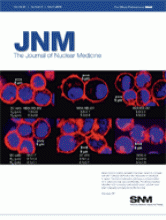REPLY: I thank Dr. Petrik and colleagues for their interest in our work (1,2). Our method of processing 68Ga eluates indeed has several advantages allowing instant kit-type synthesis procedures. First, it purifies this generator-derived positron emitter of metals such as zinc, iron, and titanium, significantly improving the yield of subsequent labeling reactions. Second, it lowers the initial breakthrough of 68Ge by more than 4 orders of magnitude down to negligible levels, thus minimizing concerns about radiopharmaceutical contamination by this long-lived radionuclide. Third, it reduces the total volume of the purified 68Ga fraction to 0.4 mL, and finally, it removes excess hydrochloric acid originating from the generator eluate. Recent improvements also demonstrate that the intermediate adsorption of purified 68Ga on the small cation exchange cartridge opens the door toward synthesis of lipophilic 68Ga-compounds in nonaqueous solvents (3).
Moreover, the removal of 68Ge represents an inherent safety procedure, as it automatically eliminates any unexpected leakage from the generator. Such a sudden dramatic problem, eventually induced by defects and incorrect handling of the generator, is neither directly seen nor avoided by using fractionation as an approach toward eluate postprocessing (4,5).
Consequently, postprocessing 68Ga eluates (1,2) has become a well-adopted procedure, applicable both to 0.1N and to 0.6N HCl eluate concentrations (for TiO2- and SnO2-based generators, respectively).
In the cation exchange-based processing chemistry and subsequent (for example) 68Ga-DOTA-octreotide synthesis and product purification steps, nontoxic ingredients such as Millipore water, saline, acetone, and ethanol are involved exclusively. Preparation and storage of these solvents and acetone/HCl mixtures in the context of application of 68Ga-labeled radiopharmaceuticals for patient diagnoses is well defined as the responsibility of the qualified persons in installation qualification, operational qualification, and standard operating procedure protocols.
Consequently, the solutions have to be prepared from high-purity batches, have to be kept in closed vials, and have to be refrigerated or stored at −20°C for a limited time only. If not, the sterility of the Millipore water and the saline solutions is not guaranteed, the composition of the acetone/HCl mixtures will change because of the low boiling points of the compounds, and the acetone in acidic media will undergo an aldol addition reaction forming 4-methyl-3-penten-2-on. We appreciate the effort of Petrik et al. to “finally” identify this well-known product, confirming the standard education of chemistry students (6).
If it was the intention of the present letter to the editor to reflect the relevancy of creating and following standard operating procedures for the synthesis of radiopharmaceuticals, we completely agree. Regarding the nontoxic compound 4-methyl-3-penten-2-on, Petrik et al. correctly state that its formation is negligible if acetone/HCl mixtures are stored with protection from light at −20°C or if freshly prepared mixtures are used.
Footnotes
-
COPYRIGHT © 2010 by the Society of Nuclear Medicine, Inc.







